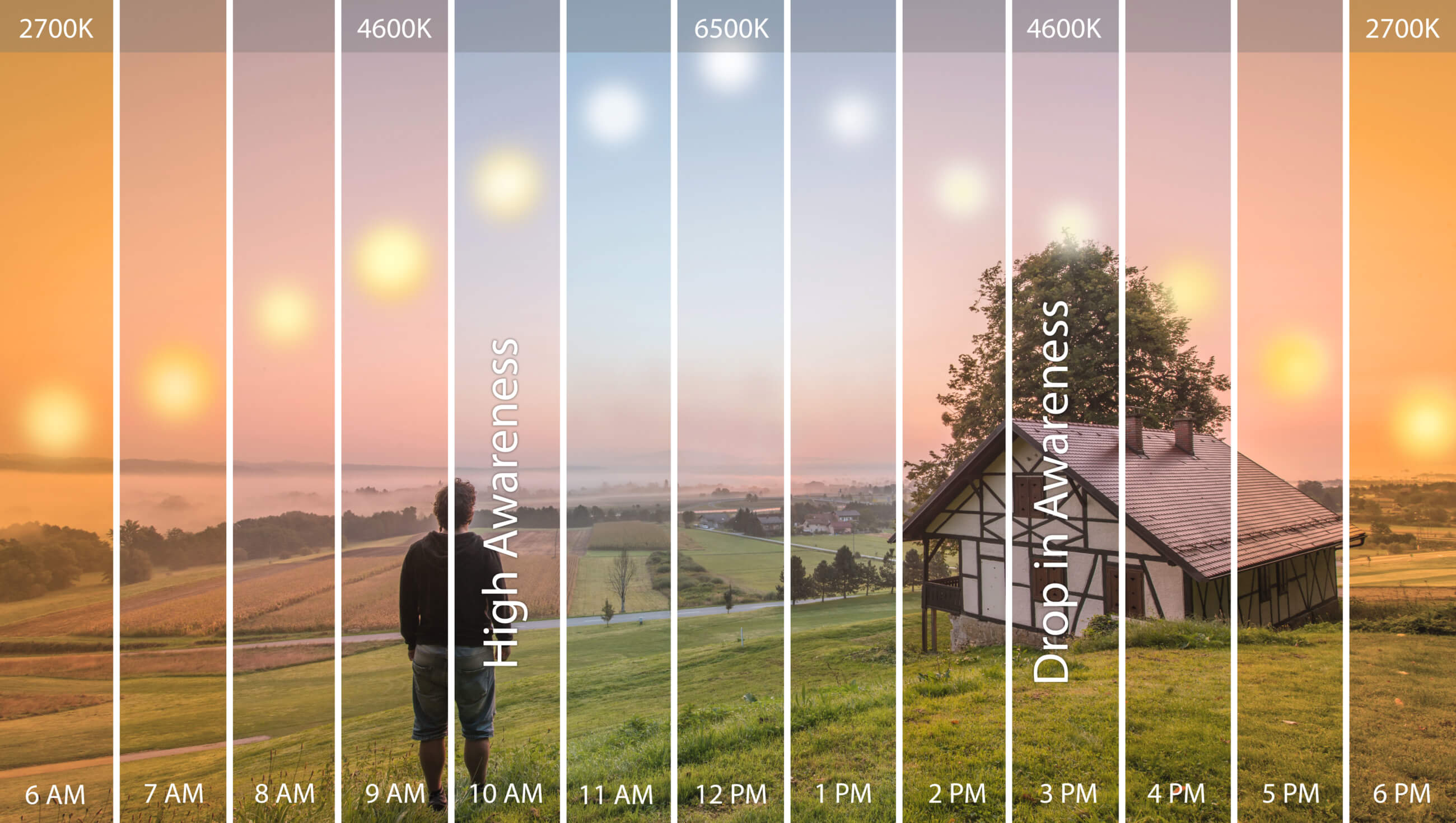What is circadian lighting?
Various sectors, from healthcare to corporate, have begun to explore the potential benefits of lighting that follow the natural sleep/wake cycles of the human body. Known as circadian lighting, these strategically designed systems may have the power to positively affect people’s health, alertness, productivity, and more.
The concept of circadian lighting follows that of the human circadian rhythm, a 24-hour internal clock. The area of the brain called the hypothalamus controls each person’s circadian rhythm by receiving signals from the eyes that report when it’s daytime and nighttime. The hypothalamus, in turn, controls the amount of melatonin released to correlate sleepiness with darkness and alertness with lightness.
Research has indicated that light affects both our visual and non-visual systems and that electric light can impact circadian rhythm. Circadian lighting is the concept that electric light can be used to support human health by minimizing the effect of electric light on the human circadian rhythm. Scientists have discovered that long-term exposure to certain wavelengths of blue light at a specific intensity can have a negative impact on melatonin production. The concept of using light to influence human circadian rhythm is a relatively new one in the lighting industry: all aspects of this exciting new topic are still being studied, and the current data is still in its infancy. At present, there are three electric light approaches to implementing a circadian lighting system: intensity tuning, color tuning, and stimulus tuning.
Intensity tuning is the most familiar and cost-effective solution to circadian lighting. Fixtures maintain a fixed correlated color temperature (CCT) while the intensity (brightness) of the fixture is adjusted, through a controlled dimming system, to correlate with time of day. Light fixtures are set to a lower intensity in the early morning, transition to a higher intensity as the day progresses, and reduce to a lower intensity in the evening.
Color tuning involves changing the light intensity and CCT to mimic the daytime/nighttime cycle. We experience cooler color temperatures (ranging from 4000K up to about 10,000K) when the sun is highest in the sky and people are typically most alert during the day. Therefore, cooler CCTs are used in spaces and during times when it’s appropriate to promote alertness and attention. Warmer color temperatures (ranging from < 2700K to 3500K) represent daylight hours when the sun is rising and setting when people are falling asleep or waking up. Circadian lighting systems are set to adjust based on the CCT we typically observe at any given time of the day.
Stimulus tuning is lighting technology that replaces the “bad blue” with “good blue” light wavelengths. This circadian lighting approach more closely mimics the daylight spectrum. Stimulus tuning light fixtures can be programmed to reduce blue light wavelengths during the evening/nighttime hours to limit melatonin suppression without changing the CCT. Similar to color tuning, this lighting approach is most effective when paired with intensity tuning.
Circadian Lighting Applications: Saint Barnabas Medical Center, Livingston, NJ
Healthcare centers are increasingly exploring circadian lighting. Studies are investigating the possible benefits to the health and recovery of long-term hospital patients. At Saint Barnabas Medical Center’s Cooperman Family Pavilion, the goal within the neonatal intensive care unit (NICU) is to increase the newborns’ exposure to natural daylight with the intention of regulating their circadian rhythm. Michael Barber and Ryan Conover specified a tunable white (color tuning) LED lighting system, which is programmed to adjust color temperature based on the time of day. Changes from cool blue to warm amber throughout the day are intended to support the newborns’ overall growth patterns and development, which can ultimately lead to shorter hospital stays.
WELL Standards for Circadian Lighting
The International WELL Building Institute (IWBI) established the WELL Building Standard to lead the design of buildings and communities to enhance comfort, health, and well-being. The IWBI offers circadian lighting standards for work areas, breakrooms, living environments, and learning areas. Feature L03, Circadian Lighting Design, is in place to provide users with appropriate light exposure to enhance circadian rhythms. In order to obtain points for this feature, all regularly occupied spaces in the project must have lighting that achieves a minimum of 120 EML (equivalent melanopic lux). Melanopic lux is measured on the vertical plane at the eye level of the occupant (about four feet off the ground). Feature L03 is an effort by WELL to create a metric for melanopic vision, which takes into account not only visual perception but also the biological, non-visual impact of light. By offering circadian lighting standards for a variety of spaces, the IWBI can assist designers as they develop lighting solutions supporting humans’ visual and non-visual needs.
As more studies and market sectors explore the uses and benefits of circadian lighting, designers will continue to refine the ways this concept can support people’s health and well-being in a variety of settings.





